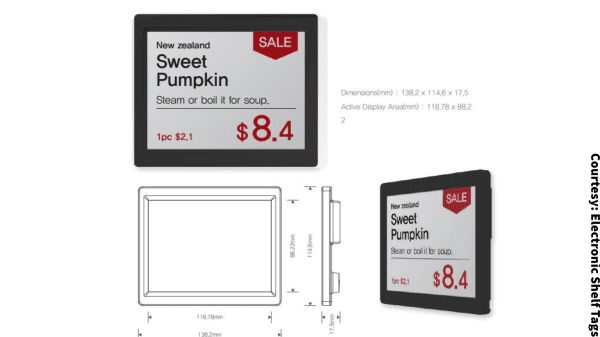Electronic shelf labels (ESLs) that can update pricing in minutes have been available for years.
“In the past, the use case was very limited,” says David Bishop, partner at Brick Meets Click in Barrington, IL, making it cost prohibitive. But technology, he adds, has made the case for usage more practical.
Today’s smart shelves include a variety of sensors, cameras, and radio frequency identification (RFID) tags used to track shelf stock. Weight sensors can alert store personnel when a shelf needs restocking.
Smart shelves enabled with RFID can also identify when a product has been put back in the wrong place. When combined with 5G wireless technology systems, smart shelves can alert a distribution center when to order inventory. Software aggregates the data to forecast stock demand.
Europe is expected to dominate ESL market share in coming years due to stringent European Union consumer protection laws, according to a Forbes Insights forecast report covering 2020 to 2027.
“More retailers have been utilizing electronic shelf labels to improve shelf availability and profitability,” says Toby Pickard, head of innovation and futures at the Institute of Grocery Distribution (IGD) in East Hertfordshire, England.
“For example, Maxima in Latvia installed ESLs at a cost of over 100,000 Euros. However, it eased employees’ workload and saved them almost 2,000 hours of work per year.
“We’re also seeing ESLs that are helping online pickers identify products on-shelf,” continues Pickard, “which helps retailers become more efficient.”
In addition to price updates, electronic labels can provide shoppers with nutritional information, promotions, and coupons that can be scanned to a shopper’s phone.
A majority (65 percent) of shoppers responding to a 2021 Pricer research survey say they would prefer more digital engagement that enables them to get product information through their mobile device.
This dovetails nicely with embedded labels, which have proximity sensors able to send product promotions to smart phones as shoppers approach products.
Consumers who create a shopping list on a store’s app receive targeted promotions based on the list and their past purchase history. Software can also analyze product sales and develop planograms to improve store displays and maximize sales.
This is an excerpt from the Applied Technology feature in the July/August 2022 issue of Produce Blueprints Magazine. Click here to read the whole issue.



